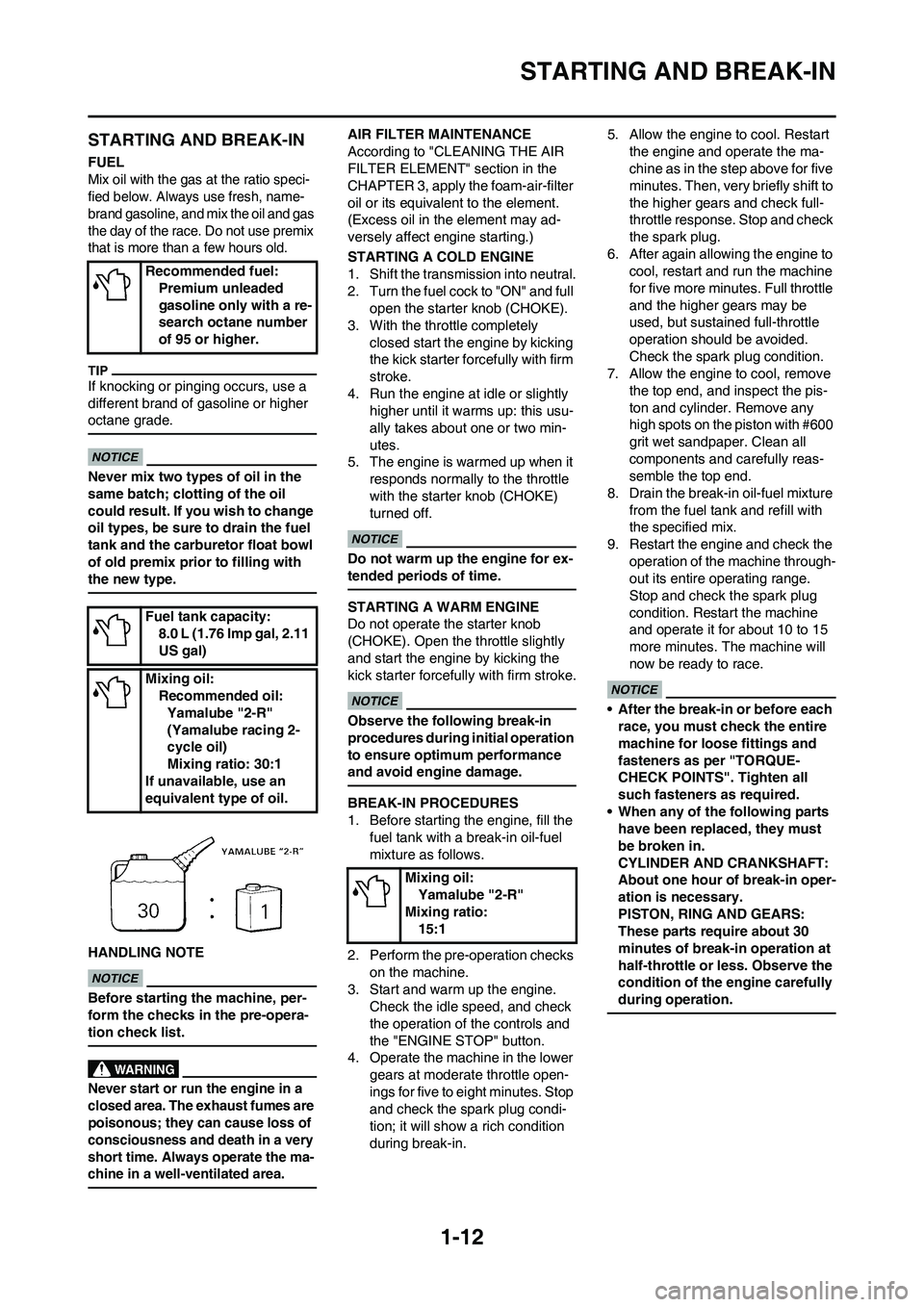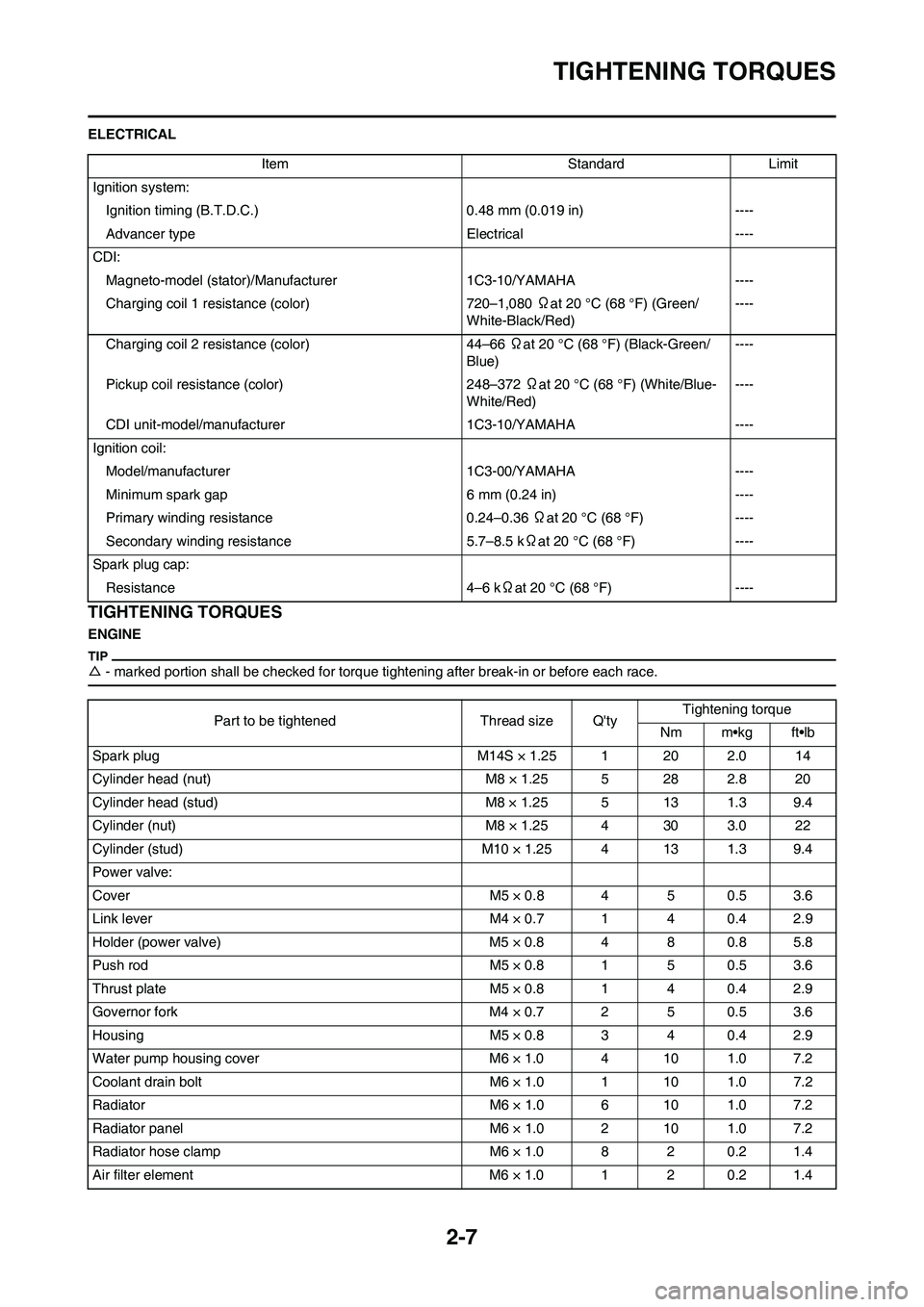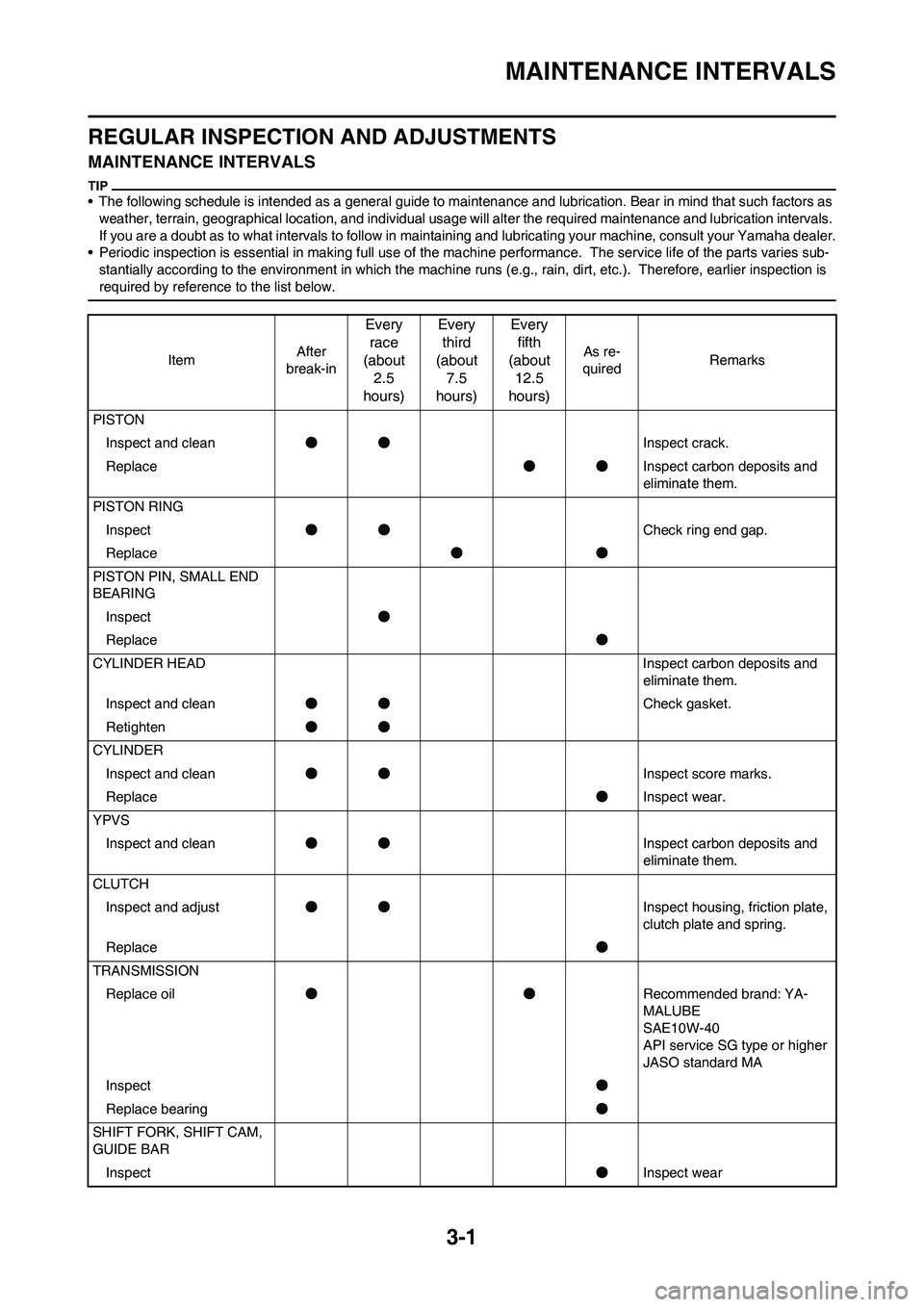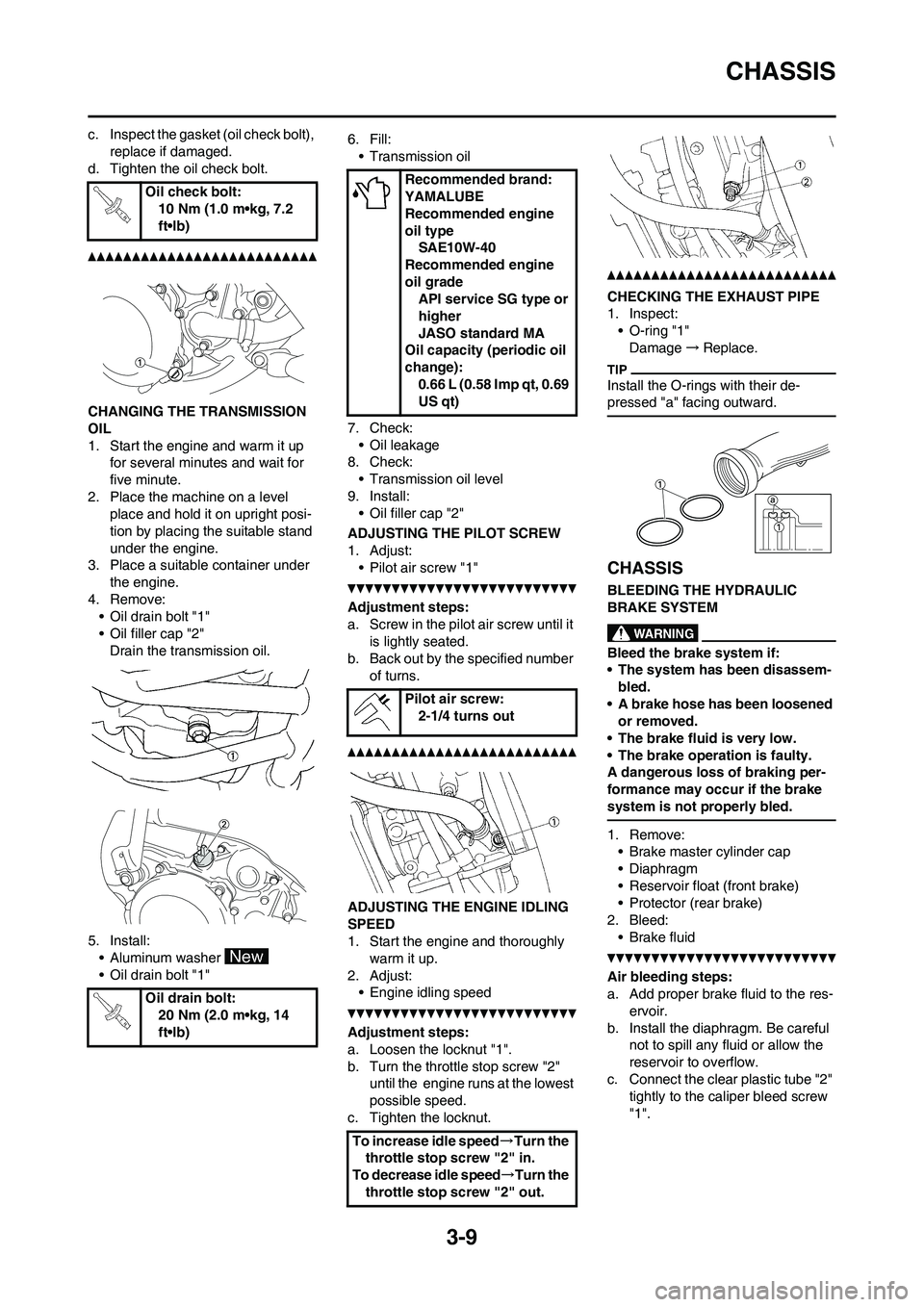oil type YAMAHA YZ125LC 2011 Owners Manual
[x] Cancel search | Manufacturer: YAMAHA, Model Year: 2011, Model line: YZ125LC, Model: YAMAHA YZ125LC 2011Pages: 166, PDF Size: 8.49 MB
Page 22 of 166

1-12
STARTING AND BREAK-IN
STARTING AND BREAK-IN
FUEL
Mix oil with the gas at the ratio speci-
fied below. Always use fresh, name-
brand gasoline, and mix the oil and gas
the day of the race. Do not use premix
that is more than a few hours old.
If knocking or pinging occurs, use a
different brand of gasoline or higher
octane grade.
Never mix two types of oil in the
same batch; clotting of the oil
could result. If you wish to change
oil types, be sure to drain the fuel
tank and the carburetor float bowl
of old premix prior to filling with
the new type.
HANDLING NOTE
Before starting the machine, per-
form the checks in the pre-opera-
tion check list.
Never start or run the engine in a
closed area. The exhaust fumes are
poisonous; they can cause loss of
consciousness and death in a very
short time. Always operate the ma-
chine in a well-ventilated area.
AIR FILTER MAINTENANCE
According to "CLEANING THE AIR
FILTER ELEMENT" section in the
CHAPTER 3, apply the foam-air-filter
oil or its equivalent to the element.
(Excess oil in the element may ad-
versely affect engine starting.)
STARTING A COLD ENGINE
1. Shift the transmission into neutral.
2. Turn the fuel cock to "ON" and full
open the starter knob (CHOKE).
3. With the throttle completely
closed start the engine by kicking
the kick starter forcefully with firm
stroke.
4. Run the engine at idle or slightly
higher until it warms up: this usu-
ally takes about one or two min-
utes.
5. The engine is warmed up when it
responds normally to the throttle
with the starter knob (CHOKE)
turned off.
Do not warm up the engine for ex-
tended periods of time.
STARTING A WARM ENGINE
Do not operate the starter knob
(CHOKE). Open the throttle slightly
and start the engine by kicking the
kick starter forcefully with firm stroke.
Observe the following break-in
procedures during initial operation
to ensure optimum performance
and avoid engine damage.
BREAK-IN PROCEDURES
1. Before starting the engine, fill the
fuel tank with a break-in oil-fuel
mixture as follows.
2. Perform the pre-operation checks
on the machine.
3. Start and warm up the engine.
Check the idle speed, and check
the operation of the controls and
the "ENGINE STOP" button.
4. Operate the machine in the lower
gears at moderate throttle open-
ings for five to eight minutes. Stop
and check the spark plug condi-
tion; it will show a rich condition
during break-in.5. Allow the engine to cool. Restart
the engine and operate the ma-
chine as in the step above for five
minutes. Then, very briefly shift to
the higher gears and check full-
throttle response. Stop and check
the spark plug.
6. After again allowing the engine to
cool, restart and run the machine
for five more minutes. Full throttle
and the higher gears may be
used, but sustained full-throttle
operation should be avoided.
Check the spark plug condition.
7. Allow the engine to cool, remove
the top end, and inspect the pis-
ton and cylinder. Remove any
high spots on the piston with #600
grit wet sandpaper. Clean all
components and carefully reas-
semble the top end.
8. Drain the break-in oil-fuel mixture
from the fuel tank and refill with
the specified mix.
9. Restart the engine and check the
operation of the machine through-
out its entire operating range.
Stop and check the spark plug
condition. Restart the machine
and operate it for about 10 to 15
more minutes. The machine will
now be ready to race.
• After the break-in or before each
race, you must check the entire
machine for loose fittings and
fasteners as per "TORQUE-
CHECK POINTS". Tighten all
such fasteners as required.
• When any of the following parts
have been replaced, they must
be broken in.
CYLINDER AND CRANKSHAFT:
About one hour of break-in oper-
ation is necessary.
PISTON, RING AND GEARS:
These parts require about 30
minutes of break-in operation at
half-throttle or less. Observe the
condition of the engine carefully
during operation.
Recommended fuel:
Premium unleaded
gasoline only with a re-
search octane number
of 95 or higher.
Fuel tank capacity:
8.0 L (1.76 Imp gal, 2.11
US gal)
Mixing oil:
Recommended oil:
Yamalube "2-R"
(Yamalube racing 2-
cycle oil)
Mixing ratio: 30:1
If unavailable, use an
equivalent type of oil.
Mixing oil:
Yamalube "2-R"
Mixing ratio:
15:1
Page 25 of 166

2-1
GENERAL SPECIFICATIONS
SPECIFICATIONS
GENERAL SPECIFICATIONS
Model name: YZ125A1 (USA, CDN)YZ125 (EUROPE, ZA)
YZ125A (AUS, NZ)
Model code number: 1C3S (USA, CDN) 1C3T (EUROPE)
1C3V (AUS, NZ, ZA)
Dimensions: USA, AUS, NZ, ZA EUROPE, CDN Overall length 2,135 mm (84. 1 in) 2,139 mm (84.2 in)
Overall width 827 mm (32.6 in) ←
Overall height 1,315 mm (51.8 in) 1,318 mm (51.9 in)
Seat height 997 mm (39. 3in) 998 mm (39.3 in)
Wheelbase 1,443 mm (56.8 in) ←
Minimum ground clearance 386 mm (15.2 in) 388 mm (15.3 in)
Weight: With oil and fuel 94 kg (207 lb)
Engine: Engine type Liquid cooled 2-stroke, gasoline
Cylinder arrangement Single cylinder, forward inclined
Displacement 124 cm
3 (4.36 Imp oz, 4.19 US oz)
Bore × stroke 54 × 54.5 mm (2.126 × 2.146 in)
Compression ratio 8.6–10.7 : 1
Starting system Kick starter
Lubrication system: Premix (30 : 1)(Yamalube 2-R)
Oil type or grade (2-stroke): Transmission oil Recommended brand: YAMALUBE SAE10W-40
API service SG type or higher
JASO standard MA
Periodic oil change 0.66 L (0.58 Imp qt, 0.69 US qt)
Total amount 0.70 L (0.62 Imp qt, 0.74 US qt)
Coolant capacity (including all routes): 0.9 L (0.79 Imp qt, 0.95 US qt)
Air filter: Wet type element
Fuel: Type Premium unleaded gasoline on ly with a research octane
number of 95 or higher.
Tank capacity 8.0 L (1.76 Imp gal, 2.11 US gal)
Carburetor: Type/Manufacturer TMX χ38SS/MIKUNI
Spark plug: Type/Manufacturer BR9EVX/NGK (resistance type)
Gap 0.6–0.7 mm (0.024–0.028 in)
Clutch type: Wet, multiple-disc
2
Page 26 of 166

2-2
MAINTENANCE SPECIFICATIONS
MAINTENANCE SPECIFICATIONS
ENGINETransmission:
Primary reduction system Gear
Primary reduction ratio 64/19 (3.368)
Secondary reduction system Chain drive
Secondary reduction ratio 48/13 (3.692)
Transmission type Constant mesh, 6-speed
Operation Left foot operation
Gear ratio:
1st 31/13 (2.385)
2nd 29/15 (1.933)
3rd 27/17 (1.588)
4th 23/17 (1.353)
5th 24/20 (1.200)
6th 23/21 (1.095)
Chassis: USA, ZA, AUS, NZ EUROPE, CDN
Frame type Semi double cradle←
Caster angle 25.5 ° 25.6 °
Trail 105 mm (4.13 in) 107 mm (4.21 in)
Tire:
Type With tube
Size (front) 80/100-21 51M
Size (rear) 100/90-19 57M
Tire pressure (front and rear) 100 kPa (1.0 kgf/cm
2, 15 psi)
Brake:
Front brake type Single disc brake
Operation Right hand operation
Rear brake type Single disc brake
Operation Right foot operation
Suspension:
Front suspension Telescopic fork
Rear suspension Swingarm (link type monocross suspension)
Shock absorber:
Front shock absorber Coil spring/oil damper
Rear shock absorber Coil spring/gas, oil damper
Wheel travel:
Front wheel travel 300 mm (11.8 in)
Rear wheel travel 315 mm (12.4 in)
Electrical:
Ignition system CDI magneto
Item Standard Limit
Cylinder head:
Combustion chamber capacity 8.4 cm
3 (0.296 Imp oz, 0.284 US oz) ----
Warp limit ---- 0.03 mm
(0.0012 in)
Page 28 of 166

2-4
MAINTENANCE SPECIFICATIONS
Clutch:Friction plate thickness 2.9–3.1 mm (0.114–0.122 in) 2.8 mm (0.110
in)
Quantity 8 ----
Clutch plate thickness 1.5 –1.7 mm (0.059–0.067 in) ----
Quantity 7 ----
Warp limit ---- 0.2 mm (0.008 in)
Clutch spring free length 40.1 mm (1.579 in) 38.1 mm (1.500 in)
Quantity 5 ----
Clutch housing thrust clearance 0.15–0.26 mm (0.006–0.010 in) ----
Clutch housing radial clearance 0.014–0.046 mm (0.0006–0.0018 in) ----
Clutch release method Inner push, cam push ----
Transmission: Main axle deflec tion limit ---- 0.01 mm
(0.0004 in)
Drive axle deflection limit ---- 0.01 mm (0.0004 in)
Shifter: Shifting type Cam drum and guide bar ----
Guide bar bending limit ---- 0.05 mm (0.0020 in)
Kick starter type: Kick and mesh type ---- Kick clip friction force P=0 .8–1.2 kg (1.8–2.6 lb) ----
Air filter oil grade (oiled filter): Foam-air-filter oil or equivalent oil ----
Carburetor: USA, CDN EUROPE AUS, NZ, ZA Type/Manufacturer TMX χ38SS/
MIKUNI ←←
I.D. mark 1C37 50 1C36 40 ←----
Main jet (M.J.) #430 ←←----
Jet needle-clip position (J.N.) 6BFY43-74-3 ←←----
Cutaway (C.A.) 4.0 ←←----
Pilot jet (P.J.) #40 #45 ←----
Pilot air screw (P.A.S.) 2-1/4 ←←----
Valve seat size (V.S.) ø3.8 mm (0.15 in)←←
----
Starter jet (G.S.) #80 ←←----
Fuel level (F.L.) 9.5–10.5 mm (0.37–0.41 in)←←
----
Reed valve: Thickness 0.47 mm (0.019 in) ----
Valve stopper height 8.2–8.6 mm (0.323–0.339 in) ----
Valve bending limi t ---- 0.2 mm (0.008
in)
Item Standard Limit
Page 29 of 166

2-5
MAINTENANCE SPECIFICATIONS
CHASSISCooling:
Radiator core size:
Width 107.8 mm (4.24 in) ----
Height (left) 240 mm (9.45 in) ----
Height (right) 220 mm (8.66 in) ----
Thickness 32 mm (1.26 in) ----
Radiator cap opening pressure 95–125 kPa (0.95–1.25 kg/cm
2, 13.5–17.8 psi) ----
Radiator capacity (total) 0.56 L (0.49 Imp qt, 0.59 US qt) ----
Water pump:
Type Single-suction centrifugal pump ----
Item Standard Limit
Steering system:
Steering bearing typeTaper roller bearing ----
Front suspension: USA, CDN, ZA, AUS,
NZEUROPE
Front fork travel 300 mm (11.8 in)←----
Fork spring free length 454 mm (17.9 in)←449 mm (17.7
in)
Spring rate, STD K=4.1 N/mm (0.418 kg/
mm, 23.4 lb/in)←----
Optional spring Yes←----
Oil capacity 524 cm
3 (18.4 Imp oz,
17.7 US oz)526 cm3 (18.5 Imp oz,
17.8 US oz)----
Oil grade Suspension oil "S1"←----
Inner tube outer diameter 48 mm (1.89 in)←----
Front fork top end 5 mm (0.2 in)←----
Rear suspension: USA, CDN, ZA, AUS,
NZEUROPE
Shock absorber travel 131.5 mm (5.18 in)←----
Spring free length Approx.265 mm (10.43
in)←----
Fitting length*----
I.D. mark (Red/1) 258 mm (10.16 in) 252 mm (9.92 in) ----
I.D. mark (Red/2) 264 mm (10.39 in) 258 mm (10.16 in) ----
I.D. mark (Red/3) 255.5 mm (10.06 in) 249.5 mm (9.82 in) ----
Preload length
in)←----
Spring rate, STD K=46.0 N/mm (4.70 kg/
mm, 263.2 lb/in)←----
Optional spring Yes←----
Enclosed gas pressure 1,000 kPa (10 kg/cm
2,
142 psi)←----
* Spring specification varies according to the differ-
ence in the production lot.Item Standard Limit
Page 31 of 166

2-7
TIGHTENING TORQUES
ELECTRICAL
TIGHTENING TORQUES
ENGINE
△- marked portion shall be checked for torque tightening after break-in or before each race.
Item Standard Limit
Ignition system:
Ignition timing (B.T.D.C.) 0.48 mm (0.019 in) ----
Advancer type Electrical ----
CDI:
Magneto-model (stator)/Manufacturer 1C3-10/YAMAHA ----
Charging coil 1 resistance (color) 720–1,080 Ωat 20 °C (68 °F) (Green/
White-Black/Red)----
Charging coil 2 resistance (color) 44–66 Ωat 20 °C (68 °F) (Black-Green/
Blue)----
Pickup coil resistance (color) 248–372 Ωat 20 °C (68 °F) (White/Blue-
White/Red)----
CDI unit-model/manufacturer 1C3-10/YAMAHA ----
Ignition coil:
Model/manufacturer 1C3-00/YAMAHA ----
Minimum spark gap 6 mm (0.24 in) ----
Primary winding resistance 0.24–0.36 Ωat 20 °C (68 °F) ----
Secondary winding resistance 5.7–8.5 kΩat 20 °C (68 °F) ----
Spark plug cap:
Resistance 4–6 kΩat 20 °C (68 °F) ----
Part to be tightened Thread size Q'tyTightening torque
Nm m•kg ft•lb
Spark plug M14S × 1.25 1 20 2.0 14
Cylinder head (nut) M8 × 1.25 5 28 2.8 20
Cylinder head (stud) M8 × 1.25 5 13 1.3 9.4
Cylinder (nut) M8 × 1.25 4 30 3.0 22
Cylinder (stud) M10 × 1.25 4 13 1.3 9.4
Power valve:
Cover M5 × 0.8 4 5 0.5 3.6
Link lever M4 × 0.7 1 4 0.4 2.9
Holder (power valve) M5 × 0.8 4 8 0.8 5.8
Push rod M5 × 0.8 1 5 0.5 3.6
Thrust plate M5 × 0.8 1 4 0.4 2.9
Governor fork M4 × 0.7 2 5 0.5 3.6
Housing M5 × 0.8 3 4 0.4 2.9
Water pump housing cover M6 × 1.0 4 10 1.0 7.2
Coolant drain bolt M6 × 1.0 1 10 1.0 7.2
Radiator M6 × 1.0 6 10 1.0 7.2
Radiator panel M6 × 1.0 2 10 1.0 7.2
Radiator hose clamp M6 × 1.0 8 2 0.2 1.4
Air filter element M6 × 1.0 1 2 0.2 1.4
Page 42 of 166

3-1
MAINTENANCE INTERVALS
REGULAR INSPECTION AND ADJUSTMENTS
MAINTENANCE INTERVALS
• The following schedule is intended as a general guide to maintenance and lubrication. Bear in mind that such factors as
weather, terrain, geographical location, and individual usage will alter the required maintenance and lubrication intervals.
If you are a doubt as to what intervals to follow in maintaining and lubricating your machine, consult your Yamaha dealer.
• Periodic inspection is essential in making full use of the machine performance. The service life of the parts varies sub-
stantially according to the environment in which the machine runs (e.g., rain, dirt, etc.). Therefore, earlier inspection is
required by reference to the list below.
ItemAfter
break-in
Every
race
(about
2.5
hours)Every
third
(about
7.5
hours)Every
fifth
(about
12.5
hours)
As re-
quiredRemarks
PISTON
Inspect and clean●●Inspect crack.
Replace●●Inspect carbon deposits and
eliminate them.
PISTON RING
Inspect●●Check ring end gap.
Replace●●
PISTON PIN, SMALL END
BEARING
Inspect●
Replace●
CYLINDER HEAD Inspect carbon deposits and
eliminate them.
Inspect and clean●●Check gasket.
Retighten●●
CYLINDER
Inspect and clean●●Inspect score marks.
Replace●Inspect wear.
YPVS
Inspect and clean●●Inspect carbon deposits and
eliminate them.
CLUTCH
Inspect and adjust●●Inspect housing, friction plate,
clutch plate and spring.
Replace●
TRANSMISSION
Replace oil●●Recommended brand: YA-
MALUBE
SAE10W-40
API service SG type or higher
JASO standard MA
Inspect●
Replace bearing●
SHIFT FORK, SHIFT CAM,
GUIDE BAR
Inspect●Inspect wear
Page 47 of 166

3-6
ENGINE
ENGINE
CHECKING THE COOLANT LEVEL
Do not remove the radiator cap
"1", drain bolt and hoses when the
engine and radiator are hot. Scald-
ing hot fluid and steam may be
blown out under pressure, which
could cause serious injury. When
the engine has cooled, place a
thick towel over the radiator cap,
slowly rotate the cap counter-
clockwise to the detent. This pro-
cedure allows any residual
pressure to escape. When the
hissing sound has stopped, press
down on the cap while turning
counterclockwise and remove it.
Hard water or salt water is harmful
to the engine parts. You may use
distilled water, if you can't get soft
water.
1. Place the machine on a level
place, and hold it in an upright po-
sition.
2. Remove:
• Radiator cap
3. Check:
• Coolant level "a"
Coolant level low→Add coolant.
1. Radiator
CHANGING THE COOLANT
Do not remove the radiator cap
when the engine is hot.
Take care so that coolant does not
splash on painted surfaces. If it
splashes, wash it away with water.
1. Place a container under the en-
gine.
2. Remove:
• Coolant drain bolt "1"
3. Remove:
• Radiator cap
Drain the coolant completely.
4. Clean:
• Cooling system
Thoroughly flush the cooling sys-
tem with clean tap water.
5. Install:
• Copper washer
• Coolant drain bolt
6. Fill:
• Radiator
•Engine
To specified level.
• Do not mix more than one type of
ethylene glycol antifreeze con-
taining corrosion inhibitors for
aluminum engine.
• Do not use water containing im-
purities or oil.
Handling notes of coolant:
The coolant is harmful so it should be
handled with special care.
• When coolant splashes to your
eye.
Thoroughly wash your eye with
water and see your doctor.
• When coolant splashes to your
clothes.
Quickly wash it away with water
and then with soap.
• When coolant is swallowed.
Quickly make him vomit and take
him to a doctor.
7. Install:
• Radiator cap
Start the engine and warm it up
for a several minutes.
8. Check:
• Coolant level
Coolant level low→Add coolant.
CHECKING THE RADIATOR CAP
1. Inspect:
• Seal (radiator cap) "1"
• Valve and valve seat "2"
Crack/damage→Replace.
Exist fur deposits "3" →Clean or
replace.
CHECKING THE RADIATOR CAP
OPENING PRESSURE
1. Attach:
• Radiator cap tester "1" and adapt-
er "2"
Apply water on the radiator cap seal.
Coolant drain bolt:
10 Nm (1.0 m•kg, 7.2
ft•lb)
Recommended coolant:
High quality ethylene
glycol anti-freeze con-
taining anti-corrosion
for aluminum engine
Coolant "1" and water
(soft water) "2" mixing ra-
tio:
50%/50%
Coolant capacity:
0.9 L (0.79 Imp qt, 0.95
US qt)
Radiator cap tester:
YU-24460-01/90890-
01325
Radiator cap tester
adapter:
YU-33984/90890-01352
Page 49 of 166

3-8
ENGINE
LUBRICATING THE THROTTLE
1. Remove:
• Cap cover "1"
• Throttle cable cap "2"
2. Apply:
• Lithium soap base grease
On the throttle cable end "a", tube
guide cable winding portion "b"
and roller sliding surface "c".
3. Install:
• Throttle cable cap
• Cap cover
CLEANING THE AIR FILTER
ELEMENT
Proper air filter maintenance is the
biggest key to preventing premature
engine wear and damage.
Never run the engine without the
air filter element in place; this
would allow dirt and dust to enter
the engine and cause rapid wear
and possible engine damage.
1. Remove:
• Seat
• Fitting bolt "1"
• Washer "2"
• Air filter element "3"
• Air filter guide "4"2. Clean:
• Air filter element
Clean them with solvent.
After cleaning, remove the remaining
solvent by squeezing the element.
• Do not twist the element when
squeezing the element.
• Leaving too much of solvent in
the element may result in poor
starting.
3. Inspect:
• Air filter element
Damage→Replace.
4. Apply:
• Foam-air-filter oil or equivalent oil
to the element
Squeeze out the excess oil. Element
should be wet but not dripping.
5. Install:
• Air filter guide "1"
Align the projection "a" on filter guide
with the hole "b" in air filter element.
6. Apply:
• Lithium soap base grease
On the matching surface "a" on air
filter element.7. Install:
• Air filter element "1"
• Washer
• Fitting bolt
Align the projection "a" on filter guide
with the hole "b" in air filter case.
CHECKING THE TRANSMISSION
OIL LEVEL
1. Start the engine, warm it up for
several minutes and wait for five
minutes.
2. Place the machine on a level
place and hold it up on upright po-
sition by placing the suitable
stand under the engine.
3. Check:
• Transmission oil level
Transmission oil level checking
steps:
a. Remove the oil check bolt "1".
b. Inspect the oil level.
Be sure the machine is positioned
straight up when inspecting the oil
level.
Never attempt to remove the oil
check bolt just after high speed
operation. The heated oil could
spout out, causing danger. Wait
until the oil cools down.
Oil flows out→Oil level is correct.
Oil does not flow out→Oil level is
low. Add transmission oil until oil
flows out. Throttle cable cap:
1 Nm (0.1 m•kg, 0.7
ft•lb)
Fitting bolt:
2 Nm (0.2 m•kg, 1.4
ft•lb)
Recommended brand:
YAMALUBE
Recommended engine
oil type
SAE10W-40
Recommended engine
oil grade
API service SG type or
higher
JASO standard MA
Page 50 of 166

3-9
CHASSIS
c. Inspect the gasket (oil check bolt),
replace if damaged.
d. Tighten the oil check bolt.
CHANGING THE TRANSMISSION
OIL
1. Start the engine and warm it up
for several minutes and wait for
five minute.
2. Place the machine on a level
place and hold it on upright posi-
tion by placing the suitable stand
under the engine.
3. Place a suitable container under
the engine.
4. Remove:
• Oil drain bolt "1"
• Oil filler cap "2"
Drain the transmission oil.
5. Install:
• Aluminum washer
• Oil drain bolt "1"6. Fill:
• Transmission oil
7. Check:
• Oil leakage
8. Check:
• Transmission oil level
9. Install:
• Oil filler cap "2"
ADJUSTING THE PILOT SCREW
1. Adjust:
• Pilot air screw "1"
Adjustment steps:
a. Screw in the pilot air screw until it
is lightly seated.
b. Back out by the specified number
of turns.
ADJUSTING THE ENGINE IDLING
SPEED
1. Start the engine and thoroughly
warm it up.
2. Adjust:
• Engine idling speed
Adjustment steps:
a. Loosen the locknut "1".
b. Turn the throttle stop screw "2"
until the engine runs at the lowest
possible speed.
c. Tighten the locknut.
CHECKING THE EXHAUST PIPE
1. Inspect:
• O-ring "1"
Damage→Replace.
Install the O-rings with their de-
pressed "a" facing outward.
CHASSIS
BLEEDING THE HYDRAULIC
BRAKE SYSTEM
Bleed the brake system if:
• The system has been disassem-
bled.
• A brake hose has been loosened
or removed.
• The brake fluid is very low.
• The brake operation is faulty.
A dangerous loss of braking per-
formance may occur if the brake
system is not properly bled.
1. Remove:
• Brake master cylinder cap
• Diaphragm
• Reservoir float (front brake)
• Protector (rear brake)
2. Bleed:
• Brake fluid
Air bleeding steps:
a. Add proper brake fluid to the res-
ervoir.
b. Install the diaphragm. Be careful
not to spill any fluid or allow the
reservoir to overflow.
c. Connect the clear plastic tube "2"
tightly to the caliper bleed screw
"1". Oil check bolt:
10 Nm (1.0 m•kg, 7.2
ft•lb)
Oil drain bolt:
20 Nm (2.0 m•kg, 14
ft•lb)
Recommended brand:
YAMALUBE
Recommended engine
oil type
SAE10W-40
Recommended engine
oil grade
API service SG type or
higher
JASO standard MA
Oil capacity (periodic oil
change):
0.66 L (0.58 Imp qt, 0.69
US qt)
Pilot air screw:
2-1/4 turns out
To increase idle speed→Turn the
throttle stop screw "2" in.
To decrease idle speed→Turn the
throttle stop screw "2" out.